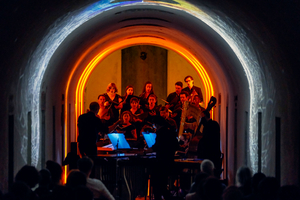Review: Snider's MASS Never Feels Endangered in Green-Wood Cemetery Catacombs
“The Angel’s Share” series, under Andrew Ousley’s “Death of Classical” banner, opens season in Brooklyn, in collaboration with Green-Wood

Green-Wood Cemetery. Photo: Kevin Condon
"Death of Classical." What's that all about?, I asked (impresario-marketing guru-consultant-artist rep, founder and artistic director) Andrew Ousley, in my first face-to-face interview since Covid became omnipresent.
"Tongue firmly in cheek, I would have to say," he said with a sly smile. 'It's how our industry, every 10 years or so, gets together and laments its own demise and worrying about audiences dying off, donors dying off, artists dying off and everybody else involved in our scene. And it never happens.
"To me, it represents what is timeless and enduring. It plays off that--and also how my concerts are frequently in crypts and catacombs," explained Ousley, who had been playing around with doing performances in nontraditional spaces for some time.
Well, the music business--along with much of the live performing arts--never felt closer to death than it did when Covid seemed to be taking over our lives. But, as Stephen Sondheim wrote, "I'm still here"--and so are Ousley's popular series of concerts that feature something old, something new, something borrowed, everything true.
The series that fall under the "Death of Classical" umbrella are "The Crypt Sessions," which takes place at the Church of the Intercession in uptown Manhattan, and "The Angel's Share," at Brooklyn's Green-Wood Cemetery, both outside and in its catacombs. (A third component, The Cave Sessions, will open this season at St. George's Church near Union Square in Manhattan.)
Last week, "The Angel's Share" kicked off its new season at Green-Wood with a deeply poignant piece, Sarah Kirkland Snider's MASS FOR THE ENDANGERED, a re-imagining of the Latin Mass with text by poet Nathan Bellows.

Both very human and heart-felt, with a score giving a sense of hope, and a visual component, by Deborah Johnson/CandyStations, that swirled around the ceiling and walls of the catacombs, engulfing the audience with images of flora and fauna. Sometimes abstract and other times figurative, it seeks to create a prism that "worships, celebrates and eulogizes" (says the composer) endangered animals and the imperiled environment in which they live. This Mass doesn't plead to God, says Snider, but directly to "Nature itself."
That's a lot to expect from a piece of music--even one as exquisitely created and performed as this one. Yet those of us in the audience felt enveloped by Snider's music and Bellows' words, performed sublimely by the Gallicantus choir, led by Gabriel Crouch, with the Decoda instrumental ensemble as first-rate collaborators in the full picture being presented. It glowed and glowered, throbbed and thumped, using a multitude of styles, with motifs going in and out of the kaleidoscopic performance.
While it was somewhat difficult to understand Bellows' words--though no worse than trying to connect with the libretto of an opera performed in English at the Met--without titles or better light in the catacombs to read the text provided, it nonetheless seemed perfectly in touch with Snider's music. The piece uses the traditional structure of the Mass (Kyrie, Gloria, Alleluia, Credo, Sanctus/Benedictus, Agnus Dei) that flickered like the candles providing the scant lighting in the room, frequently combining Bellows' libretto with some of the original Latin text.
It formed a wall of music (voices augmented by the instruments) that got under our skin, thanks to the superb work of the vocalists of Gallicantus and instrumentalists of the Decoda chamber ensemble, that somehow seemed perfectly focused for the listener in the eerie acoustics of the chamber.
MASS FOR THE ENDANGERED, which was originally commissioned by Trinity Wall Street as part of their "Mass Re-Imaginings" Project, was released on Amsterdam and Nonesuch Records.
For more information on upcoming concerts in any of the "Death of Classical" series, see its website.
Reader Reviews

Videos
